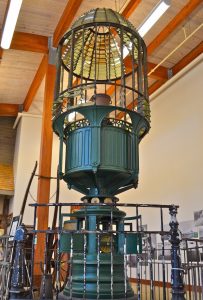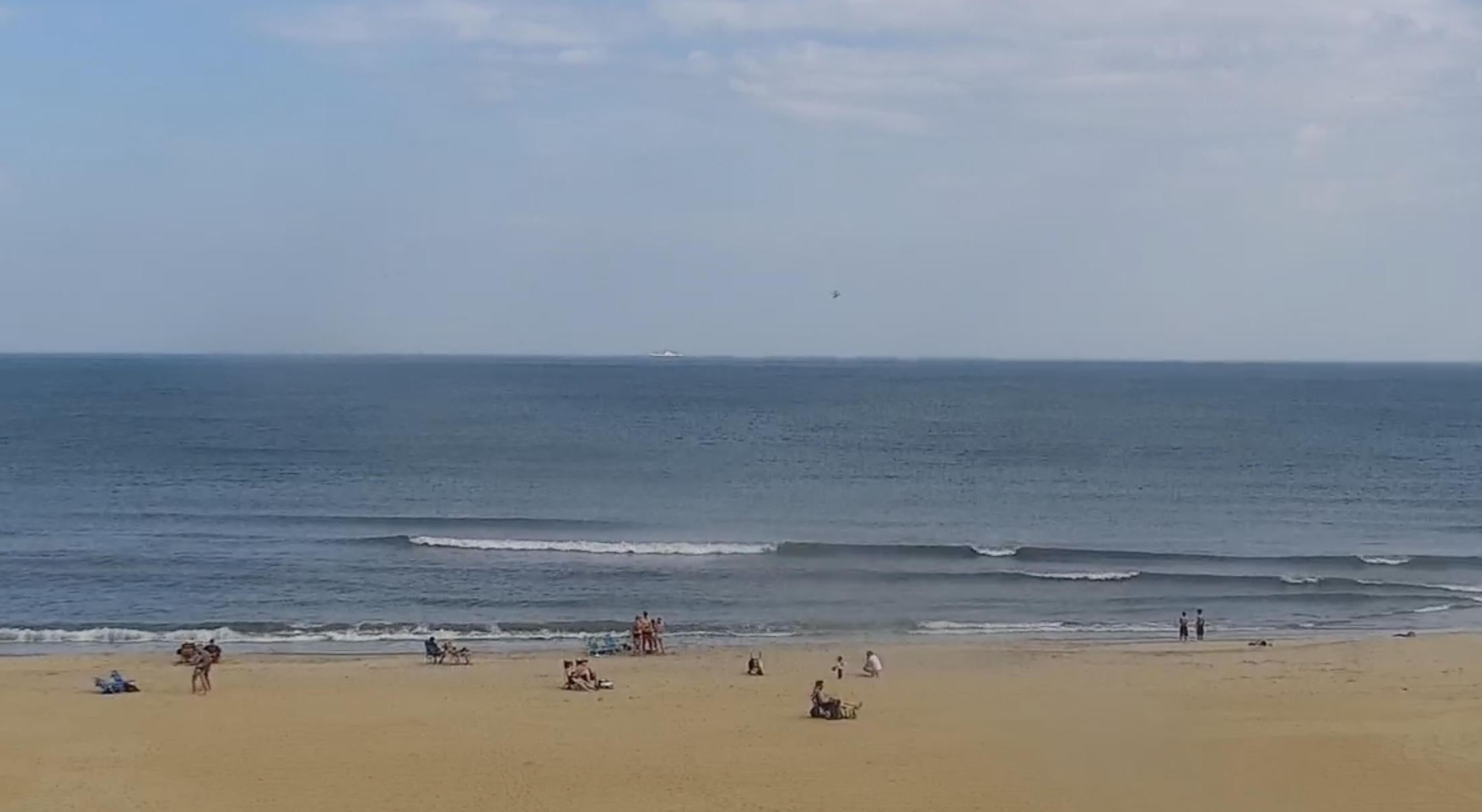
The Cape Hatteras Lighthouse Henry-Lepaute first-order Fresnel lens is the most historic lighthouse illuminating apparatus in America. It is the oldest extant lens of its size and design in the nation. It is also the most-traveled, most publicly viewed, and most-abused lighthouse artifact in the nation. Yet the lens possesses an unparalleled potential to educate and enlighten the public.
Almost 20 years ago in the summer of 2002, what remained of the nation’s most important lighthouse lens lay forlorn and forgotten on dusty shelves in hundreds of pieces at a National Park Service warehouse in the woods of Roanoke Island. That summer, after a seemingly quixotic quest comprising three years and thousands of hours of intense research and analysis, field surveys, numerous costly trips to various branches of the National Archives, I finally discovered the true and amazing history of the lens and shined a light on its eventful and tragic odyssey.

After writing a book about the history of the lens, rather than moving on to other mysteries, I continued my research of it. I knew the ending of the story of “The Lost Light” but I had yet to discover its true beginning, its prologue.
In 2010, after receiving a clue from an Oklahoma antiquarian book dealer, I was the first lighthouse historian to discover that the Cape Hatteras lens was far more historic and prominent than anyone in the modern era could have imagined. In 1853, the newly formed U.S. Lighthouse Board chose the future Cape Hatteras lens to first guide attendees at the nation’s first World’s Fair—the Exhibition of Industry of All Nations at New York City’s Crystal Palace.
A few years later, another tip from fellow lighthouse historian John Havel led me to the discovery of the lens’ original pedestal and clockwork machinery — equally as historic as the lens, as it is the oldest surviving apparatus of its kind in America — uninterrupted, unseen by the public, and unappreciated in the lantern room of the Pigeon Point Lighthouse on the California coast.
My research further revealed that the first “engineer-lampist” in the U.S. to assemble the lens and its pedestal newly arrived from its Paris manufacturer was George G. Meade, who 10 years later would defeat Lee’s army at Gettysburg. The discovery convinced me more than ever that the artifact was far more than a lighthouse lens—it was a unique oracle of American history, a sort of historical palantir, as conceived by Tolkien, a crystal through which we can observe the past, or imagine the future.
“If only historic artifacts could speak,” it is lamented. Sadly they cannot. So it is, sphinx-like, this important but disfigured lighthouse lens today stands watch over a tide of thousands of visitors to Hatteras Island at the Graveyard of the Atlantic Museum. The lens intrigues innumerable young people, enticing them to discover one of the great relics of the past. And not unlike an elderly, disabled war hero ignored by passersby while seated on a park bench, this iron, bronze and glass sentinel has a story to tell, about its stormy odyssey through time and wars, of the countless lives it has saved, of its eminence in American history.
If only historic artifacts could speak; but speak they cannot. Historians and archival records have to speak for them. When a diligent historian researches and faithfully interprets a subject, like it or not, they take on the role of its parent or curator. The historian becomes responsible for how the story is preserved.
The Cape Hatteras Fresnel lens, remarkably, survived the ravages of the Civil War as it was transported hundred of miles by horse-drawn carts, pole-propelled flats, steamboats, and the rickety rails of the Confederate railroad. For three years, the lens was likely buried beneath piles of sawdust and ice at a plantation on the North Carolina-Virginia border even while it was desperately sought by Union authorities. Considered by some to be the “holy grail” of American lighthouses, in 2006 the lens was rescued by the donors, patrons, and managers of the Graveyard of the Atlantic Museum from obscurity and years of abuse and neglect.
Yet, the historic lens faces an immeasurable peril again.
The National Park Service (NPS) is developing a plan for a project to repair the Cape Hatteras Lighthouse and restore its character-defining features. The 1870 lighthouse’s Henry-Lepaute first-order Fresnel lens, originally installed in the stone octagonal tower that preceded the current structure, is considered a character-defining feature. Under the plan’s “Alternative C: Comprehensive Improvements,” it is proposed to partially or completely restore the original Fresnel lens and reinstall it in the lighthouse with a new modern light source.

Many other lighthouse advocates and experienced engineer-lampists have expressed their concerns for the physical well-being and long-term survival of the lens should it be returned to the harsh conditions of the lantern room where it will be exposed to the harmful vibrations of the tower in high winds. It has been said that the lens, even if strengthened with acrylic prisms and center bulls-eye flash panels, would eventually be damaged or entirely destroyed as an artifact.
My concern is not just for the long-term survival of the physical lens. Should the lens, in any way, shape, or form be returned to the lighthouse, I anticipate that the historical integrity, significance, and character of the artifact will be adversely and irreparably harmed as well.
When the door to the tower was left unsecured by the Federal government in the 1940s and the lens and the pedestal were abandoned to the whims and desires of souvenir collectors, the artifacts ceased being “character-defining features” of the Cape Hatteras Lighthouse. If anything, the lens became emblematic of a lack of character.
Furthermore, if and when the once-beautiful lens is partially or completely restored with modern materials, I contend that it will no longer be the nation’s most historic first-order Fresnel lens that was once admired by more than one million visitors to New York’s Crystal Palace. The opportunity to ethically interpret that extraordinary facet of the Fresnel lens’ history will be surrendered.
And, how will the public be better served with the lens back in the lantern room? They will hardly be able to see it and those with disabilities will never see it. The lens has a far more important and valuable purpose now than occupying a lantern room and that is to teach future generations of the importance of our history and what can happen to a priceless work of art and engineering when we are insufficiently educated and inspired.
There is also some amount of support for removing the lens and pedestal from the Graveyard of the Atlantic Museum and returning it to the Cape Hatteras Lighthouse campus. While, superficially, that seems to be a logical and noble idea, it is entirely contrary to the spirit of cooperation between the National Park Service and North Carolina’s Maritime Museums. But even more shortsighted is that it will be harmful to the essential economic and tourism needs of the southern end of Hatteras Island. The Cape Hatteras National Seashore should encourage visitors to make the short journey to the museum to see the historic lens for the benefit of the many small business owners south of the lighthouse.
Most people and institutions are unaware of the long term impact of their decisions and actions, how they may someday contribute to an indelible aspect of history. The decision that is ultimately made for the future of the lens will become part of its history—a story that stands alone in the annals of American lighthouse history. Not all outcomes are good or honorable, no matter how well-intentioned.
Do we want to be remembered forever for supporting another unfortunate and regrettable chapter in the history of this American treasure?
But it is more than a treasure. The Cape Hatteras Lighthouse Henry-Lepaute first-order Fresnel lens in its present form and location is, arguably, one of the great wonders of American history. And so it should remain.

























